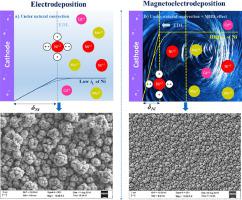Chemical Data Collections Pub Date : 2020-12-29 , DOI: 10.1016/j.cdc.2020.100639 Akshatha R. Shetty , Ampar Chitharanjan Hegde

|
The attractiveness of electroplating in the production of high performance coatings is linked to large selection of operating variables coupled with diffusion controlled mass transport process at cathode-solution interface, and this allows tailoring of different properties of the coatings. In this direction, the present communication reports the effect of magnetic field (B)on electrodeposition of Ni-Mo-Cd alloy coatings and their corrosion performances. Magnetoelectrodeposited (MED) coatings developed under different conditions of superimposed magnetic field (B), in both direction and intensity were found to exhibit far less corrosion rates (CR's), compared to conventionally electrodeposited (ED) coatings. Experimental results demonstrated that CR's MED coatings decreased with intensity of B only up to 0.3T (optimal intensity), and then started increasing. Better corrosion protection efficacy of MED coatings were explained on the basis of increased noble metal (Ni) content of the deposit, affected due to the combined effect of natural convection and Lorentz force. The effect of B on the surface morphology, composition, and phase structure, responsible for better corrosion resistance of MED coatings were discussed in the light of diffusion controlled mass transfer of Ni+2 ions, affected due to magnetohydrodynamic (MHD) effect. The constancy of diffraction peaks of ED and MED Ni-Mo-Cd coatings of all configurations indicated that crystallinity of the coating is controlled by induced B at given c.d. The effect of B on surface morphology, composition, phase structure and corrosion performance of MED coatings were analysed, using X-ray diffraction (XRD),energy-dispersive X-ray (EDX), and scanning electron microscopy (SEM) and electrochemical analyses, and results are discussed
中文翻译:

磁电沉积Ni-Mo-Cd合金涂层可提高耐腐蚀性
电镀在高性能涂料生产中的吸引力与大量选择的操作变量以及阴极-溶液界面处的扩散控制质量传输过程有关,这可以调整涂料的不同性能。在这个方向上,本通讯报告了磁场(B)对Ni-Mo-Cd合金涂层的电沉积及其腐蚀性能的影响。在叠加磁场的不同条件下开发的磁电沉积(MED)涂层(B),与常规电沉积(ED)涂层相比,在方向和强度上均显示出低得多的腐蚀速率(CR)。实验结果表明,CR的MED涂层随B强度的增加而降低,直到0.3T(最佳强度),然后开始增加。由于自然对流和洛伦兹力的共同作用,影响了镀层中贵金属(Ni)含量的增加,从而解释了MED涂层具有更好的防腐性能。从扩散控制的Ni +2传质的角度,探讨了硼对金属涂层的表面形貌,组成和相结构的影响,从而改善了MED涂层的耐蚀性。受磁流体动力学(MHD)效应影响的离子。所有配置的ED和MED Ni-Mo-Cd涂层的衍射峰的恒定性表明,在给定的cd下,涂层的结晶度受诱导B的控制。B对MED涂层的表面形态,组成,相结构和腐蚀性能的影响使用X射线衍射(XRD),能量色散X射线(EDX),扫描电子显微镜(SEM)和电化学分析进行分析,并对结果进行了讨论



























 京公网安备 11010802027423号
京公网安备 11010802027423号